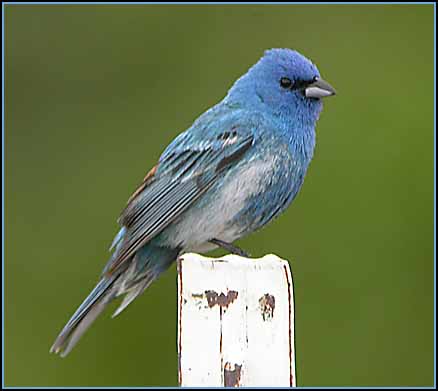tags: Lazuli x Indigo Bunting Hybrid, Passerina amoena X Passerina cyanea, birds, mystery bird, bird ID quiz
[Mystery bird] Lazuli x Indigo Bunting Hybrid, Passerina amoena X Passerina cyanea, photographed in South Dakota. [I will identify this bird for you tomorrow]
Image: Terry Sohl, 18 December 2008.
Photo taken with a Canon 50D, 400 5.6L.
Please name at least one field mark that supports your identification.
Rick Wright, Managing Director of WINGS Birding Tours Worldwide, writes:
A blue bird with a conical bill can be only a Passerina bunting. The absence of cinnamon on the wing helps us rule out the larger, bigger-billed, meaner-looking Blue Grosbeak, and points us nicely towards Indigo Bunting, a bird we've analyzed a number of times in these quizzes.
But let's look more closely. This male Passerina is extensively white on the belly and flanks, and most of the median coverts are conspicuously white-tipped; there's a little white at the tips of some of the greater coverts, too.
Indigo and Lazuli Buntings interbreed freely on the western Great Plains. In my experience, the most common plumage pattern that results is this one, with the white belly and wingbars of Lazuli and the blue breast of Indigo. I would not presume to say whether this quiz bird is the product of the pairing of "pure" parents of both taxa, but it is clear that it has the blood of both coursing through its veins.
- Log in to post comments


Male Passerina cyanea.
Blue all over, deepest on head. Black in front of eyes. Occasionally with some brown on back, wing, breast, or under tail, or whitish on belly. Wing feathers dark, edged in blue. Upper bill blackish, lower mandible blue-gray.
Lacks the reddish breast of Sialia sialis, and the bill is too heavy for any Sialia species.
Lacks the brown wing bars of Passerina caerulea, or the white bars and red breast of Passerina amoena. Color pattern is all wrong for Passerina versicolor.
Who says Latin is a dead language? :-)
I'm leaning toward indigo bunting, though I think lazuli bunting, or a hybrid, is a possibility.
Interesting bird. Not in any NA field guide that I am aware of. The beak is not large enough for Blue Grosbeak, and the white on the belly is also wrong for that species. The lack of russet on the breast rules out Lazuli Bunting, and the white belly rules out Indigo Bunting. But apparently these two "species" can hybridize where they co-occur, according to the species account for Lazuli Bunting in the Birds of North America (Greene, Erick, Vincent R. Muehter and William Davison. 1996. Lazuli Bunting (Passerina amoena), The Birds of North America Online (A. Poole, Ed.). Ithaca: Cornell Lab of Ornithology).
So I'm guessing that this is one of those hybrids.
Indigo Bunting, male. (Passerina cyanea)dark blue to black lores, smaller bill than Blue Grosbeak. BUT, the white on the sides and bit of white wing-bar is disconcerting - maybe a hybrid Indigo-Lazuli Bunting.
It's the obviously the legendary Blue Bird of Happiness.
My guess is that it's a male Indigo x Lazuli bunting hybrid. The white on the belly but lack of russet on the chest, and the white wingbar are my best clues. And this guy is from South Dakota, where the two species' ranges overlap.
Note that in these hard economic times, it is perched on an old fence post, rather than on anybody's shoulder.
You're thinking of the Bluebird of Zip-a-Dee-Doo-Dah. The Bluebird of Happiness was in a cage in your house all along.
I agree with the people who said this is an Indigo/Lazuli hybrid bunting. Someday, for a special challenge, we'll get a female hybrid to identify.